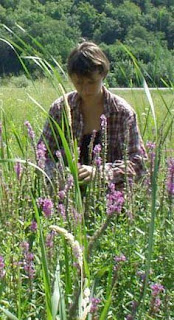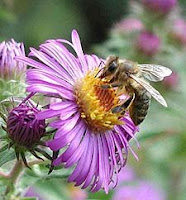the turning point
Our season and work with the honey bees starts when there is snow on the ground in March. Through the late winter, spring, and early summer for almost four months, we visit the bees and encourage them to grow into strong colonies to make honey and prepare for the next winter. We are never quite sure when the bees will start to make “surplus” honey it is much of a mystery and there are so factors that we have no control over (length and coldness of winter, rainfall and temperature in May when the bees are getting stronger, bears, the parasitic mite, the loss of bee yards and flowers to suburban sprawl)
For years I defined the ” turning point” as that specific moment in the time when we realize that the bees have made a honey crop. This moment is a relief, after months of work in the field, it is truly memorable. I will never forget the turning point of 1997, on July 5 when I found honey for the first time at the Glake bee yard. The sound of horse’s hooves and metal wheels of the Amish buggy resounded in the air from one side of the field to the other.
As we are now in the midst of our harvest this season, I see that a larger turning point has taken place. Honey Gardens Apiaries’ diversification from solely working with honey bees and offering honey to working with bees, herbs and plants to make plant medicine is well underway because of the efforts and love that two people have given us. It is time to give thanks.
Elderberry
is the first word that describes the beginning of the turning point with our work with bees.

Lewis, his father and grandfather were born here.
With Lewis’ help, we have started the Vermont elderberry project. We are growing two of Lewis’ cultivars, ” Berry Hill” and ” Coomer” and have started an orchard of elderberry plants to supply berries for our extract and also make plants available each Spring to those who want to grow elderberry, a ” Johnny Appleseed-type” project to help re-populate elderberry in the region.
Purple loosestrife
is one of the reasons that we are able to work with bees in the north. The bees gather abundant nectar from purple loosestrife each season, including the many years that there is a drought in the region. Growing in wet, swampy areas, the purple loosestrife yields abundant nectar, giving life to pollinating insects across this land. It is also pure plant medicine, and we now make a very effective throat spray & wound wash because of the help of Barbara Nardozzi. Her words about this new product describe how it works, but even more so, refer to her generous spirit and how she has helped Honey Gardens Apiaries so much in the last year.
“We never cease to be amazed in life when 
Lewis and Barbara, you have helped us to see what is all around us. Your love and ongoing support of the bees and people have truly been a blessing. You both continue to show us that the best crop in Vermont is our people.
Thank you so much.
how you may help the bees
This has been a challenging season. The honey crop came late and is a light one so far. Bears have destroyed many bee hives, and the loss of bees and honey to the bears is more than we could ever have imagined. All of this has forced us to look even deeper and more honestly at ourselves to see what we can do to be more sustainable with each other and our work at work at Honey Gardens. We have invested our energies into extending our plant medicine line, to be making products that heal and help people, using moderate amounts of our bees’ Apitherapy raw honey and plants. We are letting go of distribution of honey to such a broad geographical region. The marketing of our Apitherapy raw honey will only continue with the support in the marketplace of our plant medicine products. We appreciate your ongoing support of these at your health food stores, food cooperatives, and via our website. If these stores do not have them yet, please let us know so that we may contact them and send samples. Thank you.
 We never cease to be amazed in life when people and events come together synergistically, where their efforts and the resulting outcomes grow far beyond the potential accomplishments of a single individual. Our propolis, purple loosestrife, and Usnea wound wash, the newest product offered by the honey house, is not only the result of such synergistic human efforts, but its key ingredients are synergistic players as well. The herbs and propolis work beautifully together to promote tissue repair, heal fresh scar tissue, decrease inflammation and bleeding, stimulate local immune system functions, and act as an antibacterial, antifungal, anti-inflammatory, and antiviral agent. The astringent quality contributes its effectiveness as an antidiarrheal agent as well. In the language of wound healing, this is indeed broad spectrum coverage.
We never cease to be amazed in life when people and events come together synergistically, where their efforts and the resulting outcomes grow far beyond the potential accomplishments of a single individual. Our propolis, purple loosestrife, and Usnea wound wash, the newest product offered by the honey house, is not only the result of such synergistic human efforts, but its key ingredients are synergistic players as well. The herbs and propolis work beautifully together to promote tissue repair, heal fresh scar tissue, decrease inflammation and bleeding, stimulate local immune system functions, and act as an antibacterial, antifungal, anti-inflammatory, and antiviral agent. The astringent quality contributes its effectiveness as an antidiarrheal agent as well. In the language of wound healing, this is indeed broad spectrum coverage. the much-maligned-of-late, magenta flowered, aggressively growing wetlands perennial, is a key contributor to wound wash effectiveness. Originally introduced to the North American cut flower trade from Japan in the 1880s, perennial flower enthusiasts more recently have included it in their gardens because of its lovely spikes of purply-pink flowers. No one foresaw that purple loosestrife was a beauty who didn’t respect boundaries and as a result, she began replacing native plant wetland species. Our intention at the honey house is to take full advantage of the local abundance of purple loosestrife. We harvest it in a way that not only discourages its invasive spread into our wetland ecosystems, but also optimizes its contributions to the wound wash formula. Its wound healing properties as an antibacterial, astringent, emollient, anti-inflammatory, and antihemorrhagic (styptic) agent combine nicely with those of the propolis and Usnea. In using purple loosestrife we are removing it from ecosystems where it doesn’t belong and at the same time creating a very effective wound wash, because of its synergistic effect with propolis and Usnea.
the much-maligned-of-late, magenta flowered, aggressively growing wetlands perennial, is a key contributor to wound wash effectiveness. Originally introduced to the North American cut flower trade from Japan in the 1880s, perennial flower enthusiasts more recently have included it in their gardens because of its lovely spikes of purply-pink flowers. No one foresaw that purple loosestrife was a beauty who didn’t respect boundaries and as a result, she began replacing native plant wetland species. Our intention at the honey house is to take full advantage of the local abundance of purple loosestrife. We harvest it in a way that not only discourages its invasive spread into our wetland ecosystems, but also optimizes its contributions to the wound wash formula. Its wound healing properties as an antibacterial, astringent, emollient, anti-inflammatory, and antihemorrhagic (styptic) agent combine nicely with those of the propolis and Usnea. In using purple loosestrife we are removing it from ecosystems where it doesn’t belong and at the same time creating a very effective wound wash, because of its synergistic effect with propolis and Usnea.